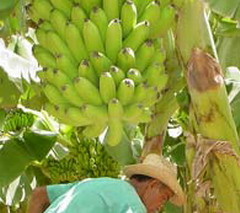Haiti produce and livestock farm, red and green in southern Camagüey
- Submitted by: admin
- Camagüey
- Science and Technology
- 05 / 15 / 2007

Juan Carlos Mata is the director of the Haiti Farm, which owns a portion of land of over 1000 hectares, out of which some 730 are devoted to raise livestock and 267 to produce fruits and vegetables.
When do you begin to apply the extra dense system in banana plantations? I ask Juan Carlos while we both strolled along the broad red tractor path.
"The Farm began to operate in 2002 and reached its productive maturity in 2006. In the strategy outlined up to 2010, we included the sowing of 50 hectares of extra-dense dessert banana, for the productive potentials its lands have and for the number of fruits per tree this variety yields, that is from 1000 to 1100 hunderweights per hectare.
"So far we have gone forth by 50 percent and we hope to acomplish the plan before the year ends".
How would you translate this into numbers?
"We had pledged to provide 12 000 hunderweights to the municipality, however we fulfilled it by 102 percent. We have set out to provide the municipality with 24 000 hunderweights in 2007, that is the double of what we harvested last year. It is predictable that for the good state of the plantations, and the yield of this area is possible a crop averaging 30 000 to 40 000 hundredweights this year.
Seven kinds of banana grow in your farm, so if one of them fails you always have the chance to continue your productions. Isnt it?
There are 254 people working in our farm. Eighty percent of these people are directly linked to the country work, while 42 men are building a policlinic and other facilities for the public wellbeing.
CATTLE RAISING, ANOTHER PRIORITY OF HAITI FARM
As it is concern for cattle raising, the workers of Haiti Farm have to build three breeding units and are working on one fattening unit. Their goal for this year is to end two breeding stockyards for beef cattle and another to fatten them.
Concerning the farmers income, those who work at Haiti Produce and Livestock Farm receive an average monthly wage of 500 pesos, and by the end of the year they perceive a percentage of the farms profits which varies from 8000 to 9000 pesos.
The labor is though; and even tougher in southern Camaguey, where the sun punishes badly, mainly at noon.
But people here fear neither the sun nor the rain, nor the roughness of working in the countryside. The excellent results of the Haiti Produce and Livestock Farm in Santa Cruz del Sur are an example of it.
Comments